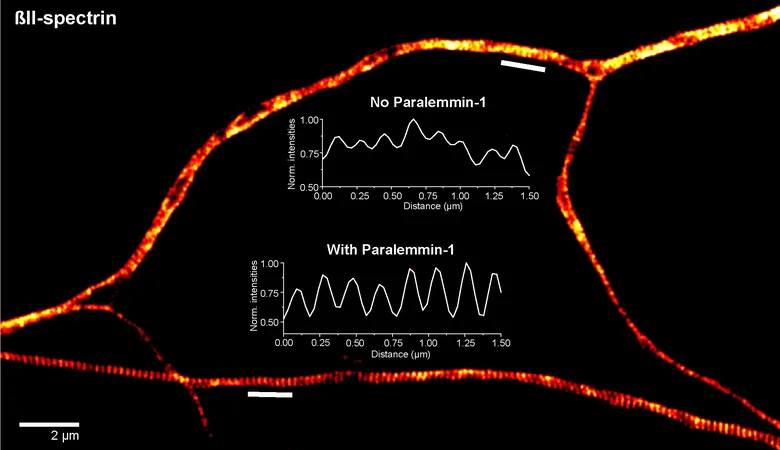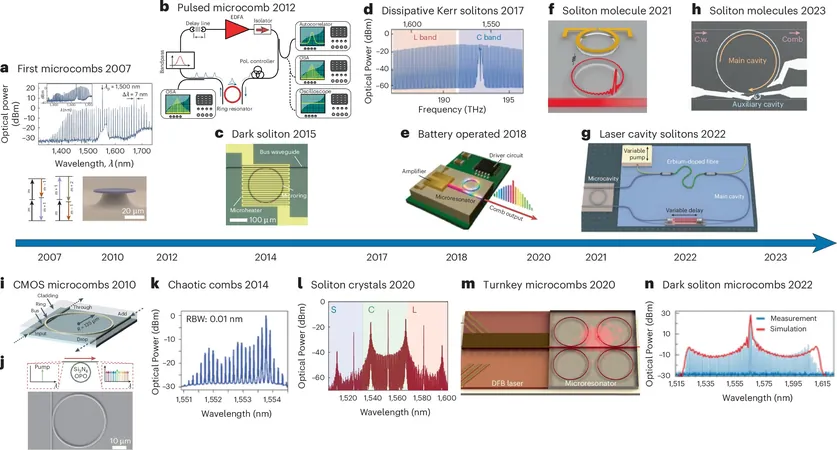
Revolutionary Breakthrough: New Protein Discovered that Shapes Neuronal Structure!
2025-04-23
Author: Ming
Unlocking the Secrets of Neuronal Architecture.
In an astounding revelation, researchers have identified a crucial regulatory protein that underpins the very structure of our nerve cells—the membrane-associated periodic skeleton (MPS). This specialized cytoskeletal feature, nestled just beneath the cell membrane, acts as a vital scaffold, organizing numerous proteins in a precise, periodic arrangement, essential for a myriad of cellular processes including both inter- and intracellular signaling.
A New Discovery in Neuronal Proteins.
Victor Macarrón-Palacios of the Max Planck Institute (MPI) for Medical Research in Heidelberg spearheaded the investigation into whether the protein paralemmin-1 intertwines with the MPS in neurons. His findings were nothing short of groundbreaking—paralemmin-1 not only associates with the MPS but plays a pivotal role in its organization.
Nanoscopy: Peering into the Cellular Depths.
Standard microscopy techniques just won’t cut it when it comes to visualizing the MPS. The researchers turned to advanced fluorescence nanoscopy—STED and MINFLUX microscopy—a technology recognized with a Nobel Prize in Chemistry in 2014. This level of precision opened up new frontiers in understanding neuronal structures.
Collaborative Genius.
This revelation is the result of a fruitful collaboration between MPI for Medical Research and MPI for Multidisciplinary Sciences in Göttingen. Manfred W. Kilimann, a retired professor and key contributor, provided vital materials and insights that propelled this study to success. With contributions spanning multiple institutes, including major universities in Heidelberg and Uppsala, this project exemplifies the power of interdisciplinary teamwork.
The Role of Paralemmin-1 Unraveled.
The findings underscore the critical importance of paralemmin-1 concentration in maintaining the organization of the cytoskeletal scaffold. High levels yield a meticulously arranged MPS, whereas lower concentrations result in disarray. Moreover, a startling implication of this discovery is that the absence of paralemmin-1 can disrupt the electrical signaling capabilities of neurons, a vital process for brain communication.
A Gateway to Future Research.
Macarrón-Palacios emphasizes that their exploration of paralemmin-1 uncovers a mechanism that fine-tunes the structure of the MPS in neurons. This involves its interaction with ßII-spectrin, a key player in the neuronal cytoskeleton, particularly in regions susceptible to mutations linked to neurological disorders in humans. The potential for this line of research to expand our understanding of brain health and disease is immense.
What Lies Ahead?
As we delve deeper into the functions and regulatory mechanisms of the MPS, we stand on the cusp of unfolding new dimensions of neurological science. This breakthrough could lead to transformative insights into neurological developmental disorders and may open doors to novel therapeutic strategies.



 Brasil (PT)
Brasil (PT)
 Canada (EN)
Canada (EN)
 Chile (ES)
Chile (ES)
 Česko (CS)
Česko (CS)
 대한민국 (KO)
대한민국 (KO)
 España (ES)
España (ES)
 France (FR)
France (FR)
 Hong Kong (EN)
Hong Kong (EN)
 Italia (IT)
Italia (IT)
 日本 (JA)
日本 (JA)
 Magyarország (HU)
Magyarország (HU)
 Norge (NO)
Norge (NO)
 Polska (PL)
Polska (PL)
 Schweiz (DE)
Schweiz (DE)
 Singapore (EN)
Singapore (EN)
 Sverige (SV)
Sverige (SV)
 Suomi (FI)
Suomi (FI)
 Türkiye (TR)
Türkiye (TR)
 الإمارات العربية المتحدة (AR)
الإمارات العربية المتحدة (AR)